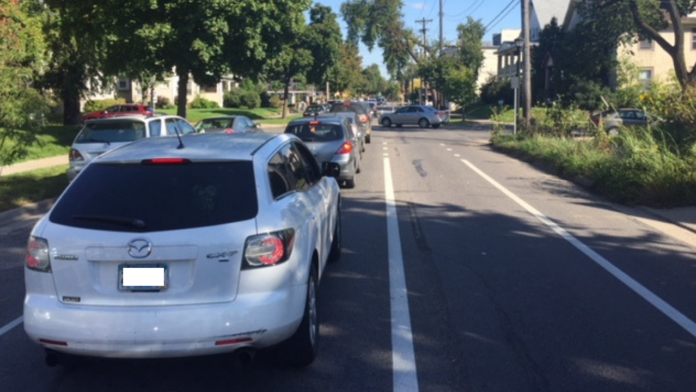The city governments of Minneapolis and St. Paul are building a network of bike lanes on streets like never before. Minneapolis has added 75 miles [that’s not a typo] of bike lanes and trails in the past six years [many of them replacing car lanes on city streets]. (Star Tribune, October 2017)
* * * *
Yesterday I called one of my best friends to schedule a breakfast – we do this about every two weeks. During the call he told me that he wants us to meet downtown this time. He chose Ike’s, a classy little restaurant on South 5th in the center of Minneapolis. When I offered alternatives and said I’d pick up the tab, he said, “Nope, it’s your turn to drive. Fair is fair.” He’s right; I have convinced him to do the driving the last three times. Who drives didn’t used to matter, because where we would meet didn’t use to matter.
We both live in Minneapolis only about 5 street miles away from each other. I used to think this was close. But not anymore. The distance is the same, but my friend and I both know that the roads are not. My neighbors are also aware, and we all visit the downtown stores and restaurants less frequently. The next door city of Edina must love what’s going on.
At 7:30 AM the most direct route to Ike’s is a 5 mile, bumper to bumper, stop and go drive, through city streets. Except in mid-afternoon, that stressful route takes about twenty minutes. And we both know that sitting in a car that long averaging 15 miles per hour is tedious. But what really irritates is that we both remember that just three years ago before the city’s bike program the same drive on the same streets, at the same time of day, took only about half as long. And we both also can see that it’s becoming noticeably worse every year.
Several major city streets have gone from two car lanes each way to one each way, with the removed car lanes turned into bike lanes along one or both curbs (curb bike lanes eliminate on street parking for nearby apartment buildings and small businesses – further adding to overall congestion).
The fact is that this worsening situation was created on purpose by a seemingly disinterested Minnesota Department of Transportation, a politically correct Metropolitan Council and Minneapolis City Council, wishing to make drivers so miserable that they would abandon their cars, and use the government’s trains and buses, or ride bicycles.
Larry Ludeman, is a board member of the Lyn-Lake Business Association, and an ally of my view. “What our city leaders are doing to our street transportation system is ‘prescribed congestion’ for the sake of a grand, arrogant, behavior modification program. We thought common sense might prevail, and Minneapolis would delay the installation of the bike lanes [when traffic problems became obvious]. But no. What they don’t seem to care about are the costs due to lost citizen time, fuel, and income. And the additional emissions [from longer drive times] is hurting the environment.”
A study by the Center of the American Experiment agrees with Mr. Ludeman. Their research shows that “Driver wait times while sitting in traffic have quadrupled since 1982. This has created congestion costs to the Twin Cities metro area of nearly $4 billion per year in wasted time and increased business costs.”
But not all agree. One wag told me recently that I’ll feel differently when fewer people are driving on the roads – making them more empty for me in my car. I didn’t know what to say in response to such irrational reasoning, and just stared at her.
So this summer I decided that I’d second guess myself and actually count the number of bike riders the city has on the streets as a result of this several year-old program. I counted three times. My sample was admittedly small, but the average of about 16 riders during the twenty-minute drive cannot possibly be taking many cars off the street. And I can only guess at the reduced bike totals that during February and March when 20 degree days and icy streets are routine.
My observations matched exactly those of Mr. Rick Brimacomb, who complained in the Star Tribune, “The bike lanes are maddening, especially when traffic is heavy. Parking spots are limited, and there are few cyclists in sight. [The city] is pitting the 2 percent against the 98 percent.”
Most of those opposed to this policy know that the City of Minneapolis will not abolish its taxpayer funded Bicycle Advisory Committee (BAC), the mission of which is to “promote both commuter and recreational bicycling, to advocate for bicycling infrastructure improvements, to encourage safe riding, and to involve people interested in bicycling issues throughout the city.” Simply stated, they just have too much skin in the game to turn tail just to benefit the ninety-eight percent of the population who are driving to work. What to do?
I’ve decided to continue driving downtown when it’s my turn to meet my friend or attend a conference held there. And my wife and I shall continue to buy season tickets to the Guthrie Theater. Some things are not replaceable; but thankfully most others are.
But from now on I’m searching for replacements for Minneapolis attractions. My one-man boycott has begun. I’m also betting that thousands of others have already or shall be adopting that same plan.








